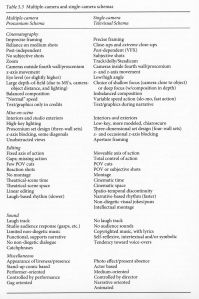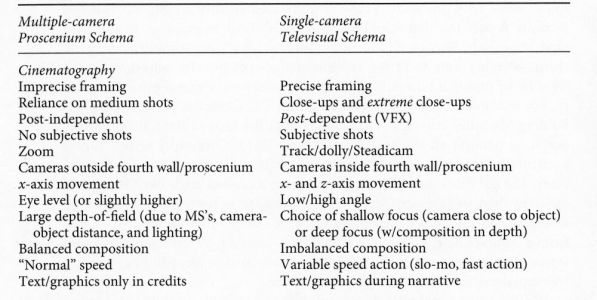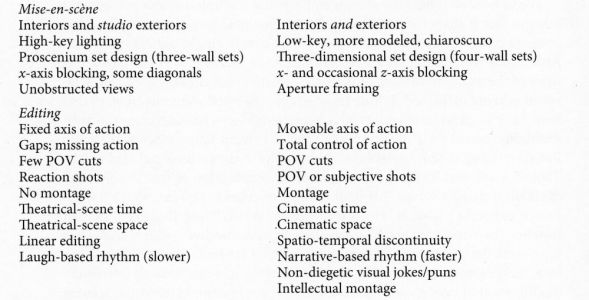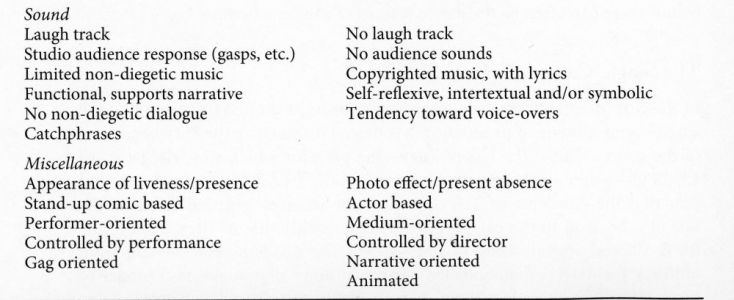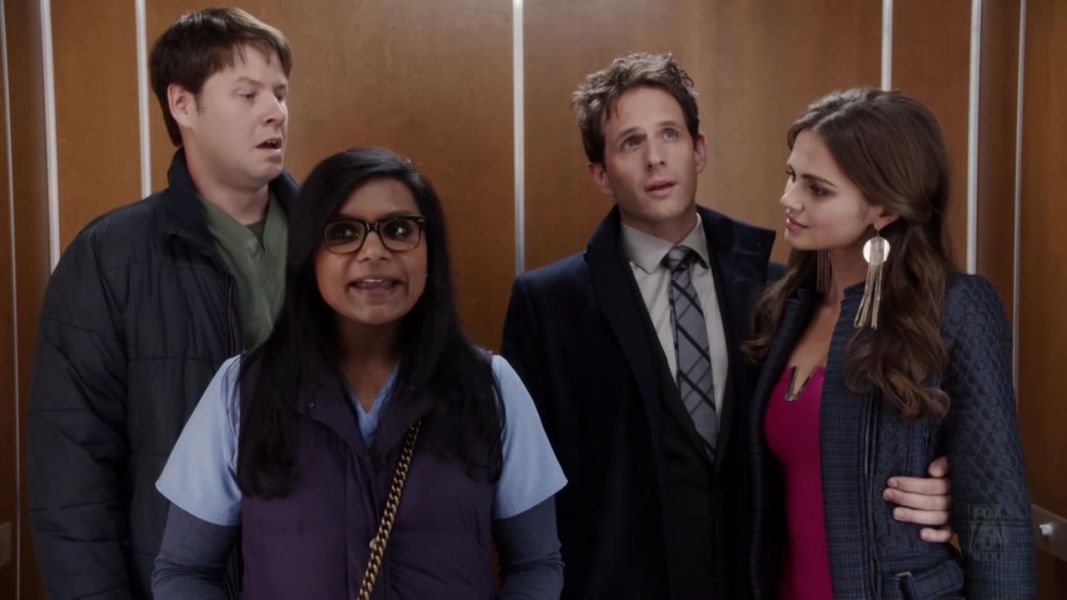Difference between pages "TCF340/BordwellThompson/Narrative Form (Discussion)" and "Style and Stylistics (Discussion)"
From Screenpedia
(Difference between pages)
Jump to navigationJump to search (→"Televisuality and the Resurrection of the Sitcom in the 2000s": added comedy vérité) |
|||
| Line 1: | Line 1: | ||
| − | == | + | =="Televisuality and the Resurrection of the Sitcom in the 2000s"== |
| − | + | <gallery mode="packed" heights=200px> | |
| − | + | File:Table 5.3-resized.jpg|alt=Television Style, table 5.3|''Television Style'', table 5.3 "Multiple-camera and Single-camera Schemas," full table. | |
| − | + | File:Table 5.3 part 1 Cinematography.jpg|alt=Television Style, table 5.3|Table 5.3: Cinematography. | |
| − | + | File:Table 5.3 part 2 MeS and Editing resized.jpg|alt=Television Style, table 5.3.|Table 5.3: Mise-en-Scene and Editing. | |
| − | + | File:Table 5.3 part 3 Sound and Misc resized.jpg|alt=Television Style, table 5.3.|Table 5.3: Sound and Miscellaneous. | |
| − | + | </gallery> | |
| − | < | ||
| − | |||
| − | + | View a scene from ''The Mindy Project'' (see Blackboard and [http://tvcrit.org/Classes/Jbutler/BUI301/MindyProject_20131112/index.html screenshots online]). | |
| − | + | *'''Table 5.3''' in "Televisuality and the Resurrection of the Sitcom in the 2000s" (see above) lists elements of the "single-camera televisual schema". | |
| + | **How many of those single-camera elements do you see in ''The Mindy Project'' scene? Each group will account for one or two groups of elements (click a thumbnail above to enlarge it): | ||
| + | **#'''Group 1:''' cinematography | ||
| + | **#'''Group 2:''' mise-en-scene | ||
| + | **#'''Group 3:''' editing | ||
| + | **#'''Group 4:''' sound ''and'' "miscellaneous" | ||
| + | *'''All groups:''' '''Table 5.6''' from the essay outlines a "televisual continuum"--ranging from ''very'' televisual (''The Simpsons'') to not televisual at all (school-play recordings). | ||
| + | *#What does the term "televisual" mean--as conceived by John Caldwell (see p. 175)? | ||
| + | *#Where does ''The Mindy Project'' fit on the continuum? Table 5.6 puts ''The Honeymooners'' in the second category, ''The New Adventures of Old Christine'' ([[Editing: Multiple Camera Mode (Discussion)|which we discussed three weeks ago]]) in the third category, and ''Scrubs'' in the fifth category. | ||
| + | *#Where would you place ''The Office'' (see Ethan Thompson's and Brett Mills's discussion of comedy ''vérité ''; p. 214? | ||
| − | + | <gallery mode="packed" heights=400px> | |
| + | File:Mindyproject 20131112qq00 00 55qq00040.jpg|alt=The Mindy Project screenshot.|Morgan, Mindy, Cliff, and Yana (from left). | ||
| + | </gallery> | ||
| − | == '' | + | ==''Television: Visual Storytelling and Screen Culture''== |
| − | + | #'''All groups''': Explain how the textbook defines the term "style" in your own words. | |
| − | + | #'''Group 1:''' Explain the work of "evaluative" and "descriptive" stylisticians. How might they approach ''The Mindy Project''? | |
| − | # | + | #'''Group 2:''' Explain the work of "analytic" stylisticians. How might they approach ''The Mindy Project''? Be ready to define the following purposes or "functions" of style discussed in the textbook. |
| − | + | #*symbolize | |
| − | + | #*decorate | |
| − | + | #'''Group 3:''' Explain the work of "analytic" stylisticians. How might they approach ''The Mindy Project''? Be ready to define the following purposes or "functions" of style discussed in the textbook. | |
| − | # | + | #*persuade |
| − | + | #*hail or interpellate | |
| − | + | #*differentiate | |
| − | # | + | #'''Group 4:''' Explain the work of "historical" stylisticians. How might they approach ''The Mindy Project''? Be ready to define these terms: "craft practices" and "schemas." |
| − | |||
| − | # | ||
| − | # | ||
| − | # | ||
| − | # | ||
| − | |||
| − | |||
== Bibliography == | == Bibliography == | ||
| − | # | + | #Butler, Jeremy G. ''Television: Visual Storytelling and Screen Culture''. NY: Routledge, 2018. |
| + | #Butler, Jeremy G. "Televisuality and the Resurrection of the Sitcom in the 2000s," in ''Television Style'' (NY: Routledge, 2010), 173-222. | ||
==External links== | ==External links== | ||
| − | + | *[https://www.tvstylebook.com/ ''Television Style'' official homepage] | |
| − | + | *[https://tvcrit.org/Classes/Jbutler/BUI301/MindyProject_20131112/index.html ''The Mindy Project'' screenshots] | |
| + | *[https://criticalcommons.org/Members/jbutler/clips/blending-multiple-camera-and-single-camera/ Hybrid mode of production] in ''How I Met Your Mother'' | ||
| + | *[https://tvcrit.org/Classes/Jbutler/BUI301/NewAdventuresofOldChristine/ ''The New Adventures of Old Christine'': screenshots] | ||
| + | *[https://tvcrit.org/Classes/Jbutler/BUI301/NewAdventuresofOldChristine/Table%20502_OldChristine.pdf ''The New Adventures of Old Christine'': découpage] | ||
| − | [[Category: | + | [[Category:BUI301]] |
| + | [[Category:BUI301 Discussion]] | ||
| + | [[Category:JCM311]] | ||
| + | [[Category:JCM311 Discussion]] | ||
Revision as of 18:24, 22 October 2020
"Televisuality and the Resurrection of the Sitcom in the 2000s"
View a scene from The Mindy Project (see Blackboard and screenshots online).
- Table 5.3 in "Televisuality and the Resurrection of the Sitcom in the 2000s" (see above) lists elements of the "single-camera televisual schema".
- How many of those single-camera elements do you see in The Mindy Project scene? Each group will account for one or two groups of elements (click a thumbnail above to enlarge it):
- Group 1: cinematography
- Group 2: mise-en-scene
- Group 3: editing
- Group 4: sound and "miscellaneous"
- How many of those single-camera elements do you see in The Mindy Project scene? Each group will account for one or two groups of elements (click a thumbnail above to enlarge it):
- All groups: Table 5.6 from the essay outlines a "televisual continuum"--ranging from very televisual (The Simpsons) to not televisual at all (school-play recordings).
- What does the term "televisual" mean--as conceived by John Caldwell (see p. 175)?
- Where does The Mindy Project fit on the continuum? Table 5.6 puts The Honeymooners in the second category, The New Adventures of Old Christine (which we discussed three weeks ago) in the third category, and Scrubs in the fifth category.
- Where would you place The Office (see Ethan Thompson's and Brett Mills's discussion of comedy vérité ; p. 214?
Television: Visual Storytelling and Screen Culture
- All groups: Explain how the textbook defines the term "style" in your own words.
- Group 1: Explain the work of "evaluative" and "descriptive" stylisticians. How might they approach The Mindy Project?
- Group 2: Explain the work of "analytic" stylisticians. How might they approach The Mindy Project? Be ready to define the following purposes or "functions" of style discussed in the textbook.
- symbolize
- decorate
- Group 3: Explain the work of "analytic" stylisticians. How might they approach The Mindy Project? Be ready to define the following purposes or "functions" of style discussed in the textbook.
- persuade
- hail or interpellate
- differentiate
- Group 4: Explain the work of "historical" stylisticians. How might they approach The Mindy Project? Be ready to define these terms: "craft practices" and "schemas."
Bibliography
- Butler, Jeremy G. Television: Visual Storytelling and Screen Culture. NY: Routledge, 2018.
- Butler, Jeremy G. "Televisuality and the Resurrection of the Sitcom in the 2000s," in Television Style (NY: Routledge, 2010), 173-222.
